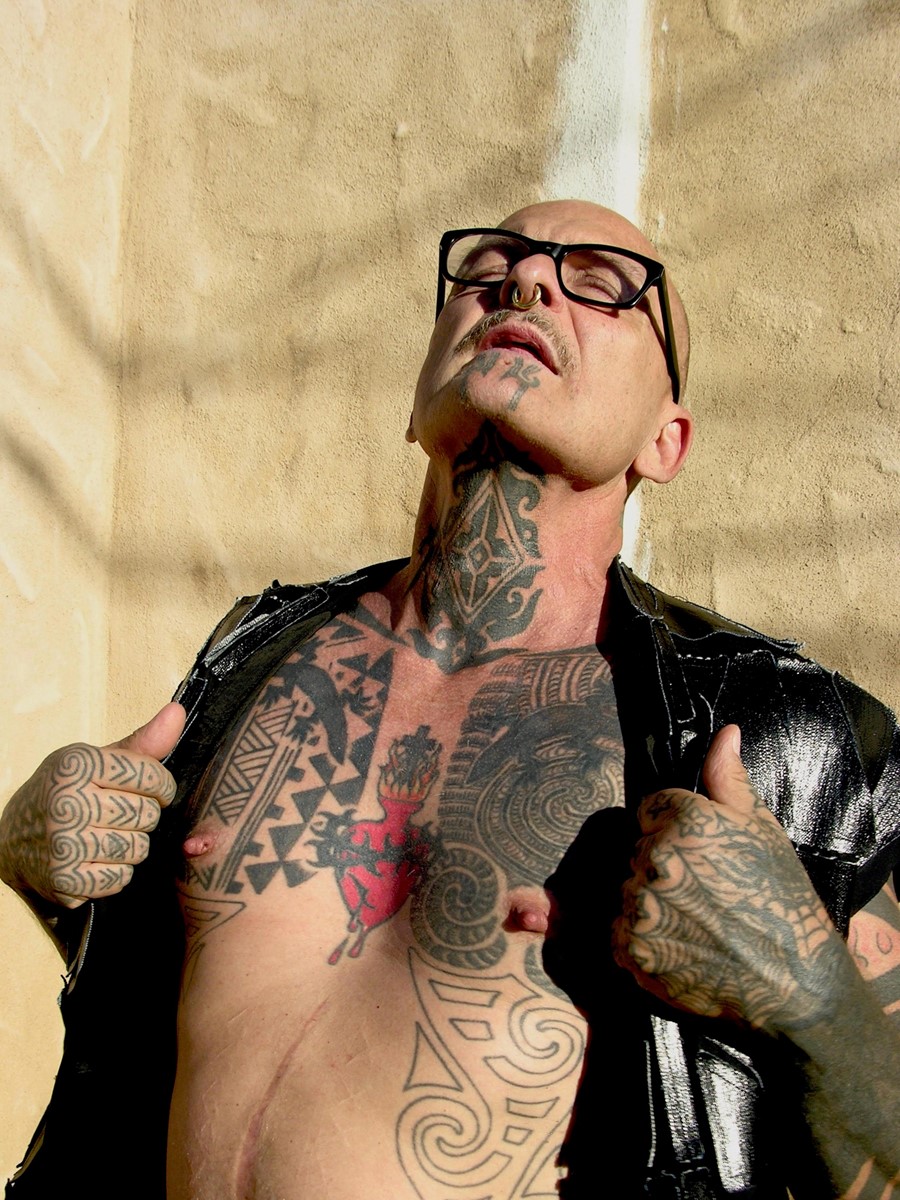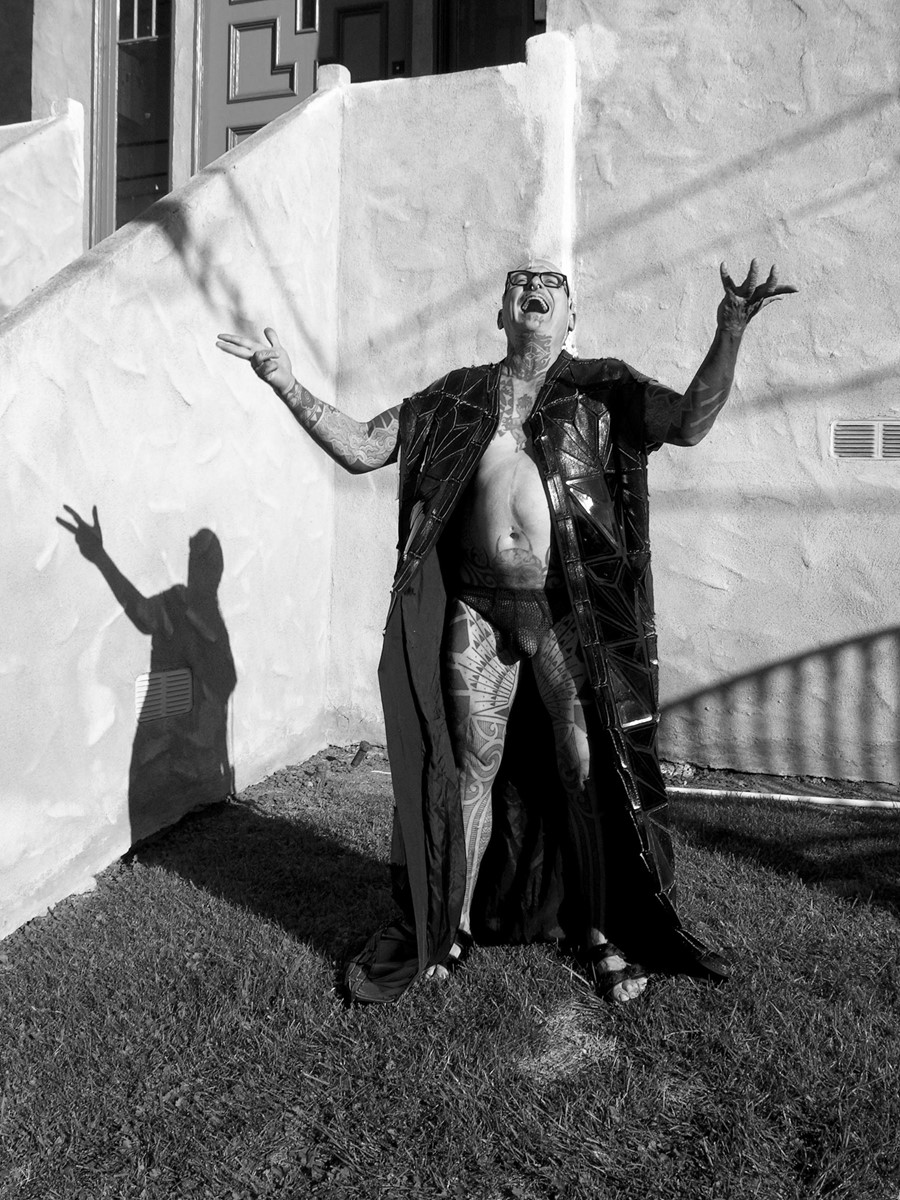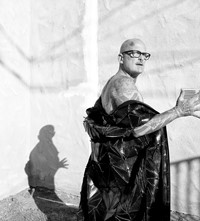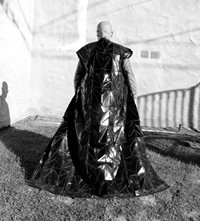Fetish Photographer Rick Castro Meets Extreme Performance Artist Ron Athey
- TextRick Castro
Speaking to Rick Castro, Ron Athey opens up about his subversive performance art, his relationship with goth pioneer Rozz Williams, life as a person with AIDS, and more
Once an obscure practice by underground artists presented to other underground artists in backrooms and dingy lofts, performance art is finally having its time in the limelight.
I had the pleasure of witnessing the first performances by Los Angeles legends Johanna Went and Priscilla B at Vinyl Fetish Record Shop way back in 1978. Fast on the heels of these performance divas was Ron Athey, who brought his personal experience of holy rolling, BDSM, blood, splatter, piercings, homages to classic gay icons, and many forms of penetration.
There’s a group of one-of-a-kind personalities that was ground zero of creative Los Angeles during the late 70s, early 80s who have influenced the world with an aesthetic, that in my opinion, is uniquely LA. I’m referring to people like Rick Owens, Vaginal Davis, Catherine Opie, Alice Bag, Rhonda Saboff and Gai Gherardi (LA Eyeworks), models Jenny Shimizu and Tony Ward, Durk Dehner (Tom of Finland Foundation), Glen Meadmore, Joseph Brooks and Henry Peck (RIP), creators of Vinyl Fetish Record Shop, numerous nightclubs including The Veil and Fetish, me, (if I may be so bold), Rozz Williams (RIP), and Ron Athey.
Athey’s early performance received minor funding by the Walker Art Center, Minneapolis. The Human Printing Press (1994) featured Ron Athey making cuts in co-performer Divinity Fudge’s back, placing strips of absorbent paper towel on the cuts and then, using a pulley, hoisting the blood-stained cloths above the audience. The then-widespread anxiety about AIDS, unawareness and fear with S&M-related art, garnered the ire of right-wing alarmist Jesse Helms, who falsely described Athey’s performances as exposing audience members to HIV-infected blood. Senator Helms denounced Athey by name on the senate floor, thus sealing his infamy.
I’ve known Ron Athey since the 1980s! We got together at his home in Silverlake for a shoot and a chat.
Rick Castro: How did you and I meet?
Ron Athey: Michael Morrison parties with Beverly Klein and Lisa Teasley? Earlier at an Afro Sisters do? Ladies of the 80s.
Rick Castro: I remember you at Michael Morrison’s jewellery atelier on Hollywood Boulevard circa 1985... You were the first person I met who had face tattoos, who wasn’t in prison. When I look back now, you actually didn’t have that many, but at the time it seemed very extreme.
Ron Athey: There was a higher price for it then, everyone suspicious, always getting held in customs. Confrontation on the RTD!
Rick Castro: What was growing up in Pomona like?
Ron Athey: South Pomona. Gang bang-y, angel dust, broken glass. But also rural, it borders pre-trackhouse Chino when there were small ranches and drive-thru dairies.
Rick Castro: Is this where you learned the high art of holy rolling?
Ron Athey: We chased evangelists around from deep in the Inland Empire, to storefront churches in Rosemead, the only contact to LA proper was going to see Miss Velma’s illustrated sermons a few times a year. It was strange for me when she announced the unveiling of the Golden Revelation Tree of Life and all the Cacophony Society people were there undercover. Now there’s a bit in a Frank Zappa collection where he recounts going into Miss Velma’s church!
Rick Castro: Tell me about your relationship with Rozz Williams. Was he good in bed?
[In my opinion, Rozz Williams single-handedly invented American goth music in 1978 – so goth was invented in Pomona, CA!]
Ron Athey: Rozz was the door to more culture than punk rock! We had a love and art relationship, and took a lot of acid. I met him in a garage in Claremont, Christian Death were rehearsing/developing material, they hadn’t played in LA. yet.
Rick Castro: You didn’t respond to the ‘was he good in bed question’... Too garish?
Ron Athey: Too corny! He was 16 and I was 18, very experimental and crazy. I have diary pages he wrote about the time we tried to hitch-hike to San Diego on acid, followed by his dream that I was kept in a box dismembered and my liver kept falling out! He was a good time Sally and gender-fluid. We were together, then Eva O became a part of our world (we slept in a small bed in a walk-in closet in Long Beach!
Rick Castro: What and where was your first performance art?
Ron Athey: Premature Ejaculation. Me and Rozz were hugely inspired by Johanna Went, directly, and the grislier Viennese Actionist spreads from High Performance Magazine. We were a noise/action unit, otherwise known as PE. It was at Arts Building Jr at the Pomona Mall, two performances both in 1981.


Rick Castro: Fond memories of Club Fuck!?
Ron Athey: Yes! Being a go-go dancer from 1990-1993 was therapy on the deepest level! And the mod-mod moment coming to a peak and then eating itself up. The foundation of all the performance I did in the 90s, any relationship to activism and real scenes, came from that moment. Also working with people for years from that scene, Divinity (Fudge), Pigpen, Sheree Rose.
[Club Fuck! was the premiere fetish nightclub in los angeles, featuring modern primitives, tattoo and piercings, all genders, sexualities and anything in-between, early industrial and hard house music, live bands like P.M.E. & kinky performance art. I remember being with Miguel Beristain and Cliff Diller in San Francisco during Gay Pride 1989. They were so inspired by the one-off club scene, they hurried back to LA, and a few months later Club Fuck! Was born. The scene was hot from 1989-1993, then morphed into something else.]
Rick Castro: What did Seymore Kasabian mean to you?
Ron Athey: I have belief that you can enter through your idea of a character, but it’s where it lands that’s profound. Seymore’s alter ego Wynonna Judd came about by trying an Ann-Margret look, but instead of being fat Ann I was the embodiment of Wynonna. Seymour’s masculinity just came out shy and greasy, creepy… But I keep forgetting he was a serial killer!
[By the way dear readers, I cast Ron Athey as Seymore Kasabian; mortician, cross-dresser and serial killer in my first feature film Hustler White (1996) co-directed and wrote with Bruce LaBruce. The character name is based on gonzo porn star/director Seymore Butts and Manson family member Linda Kasabian.]
Rick Castro: Did leaving LA help your career?
Ron Athey: Maybe it gave me perspective? I worked in the UK since the early 90s, moving to London in 2009, to get married! Wasn’t a huge stretch, it was somewhere I have a lot of deep connections, and the love obsession was the final push. I didn’t find myself working more in Europe than I do here, actually! And the bad Brexit feelings, to be pressed between that and this Trump nightmare. Career? Performance Art is a strange hustle.
Rick Castro: How about coming back?
Ron Athey: But six years of British misery... I’m glad to be back in California. Even before I came back the blacklist ended and I started doing things in museums again. Sebastiane at the Hammer, group show at MOCA, I’ve been produced and programmed workout at The Broad. LA has grown up into a monster in the meantime, some things brilliant, but New York shrill pace and newly priced out status isn’t cute. Artists are always driven out by money pigs.
Rick Castro: What was the reaction to your performances from the UK and Euro compared to AmeriKKKa?
Ron Athey: I’ve done more pieces in the UK than in the US! I have 25-year relationships with a lot of venues, in Birmingham, in Ljubljana, that I return to when I have new work. Western world engagement. The only sharp differences have been some former East Bloc countries. Warsaw was AIDS-phobic even in 2010, doing a show with anal penetration in Zagreb a year after the war was also pushing it! Just depends on the context of who’s presenting you, and if any conservative groups know how to use you as a weapon.


Rick Castro: Has performance art finally come into its own?
Ron Athey: Yes, for better or worse, it’s taught at all art schools, so the work has become more academic and refers to itself. But the cheesy flirtation by celebrities has made some general public look deeper. I was visiting artist at a Methodist College in Shreveport Louisiana a few years ago and one of the drama students asked me if what I did was like Shia LaBeouf. I said totes.
Rick Castro: Will performance art become mainstream?
Ron Athey: Yes, for about as long as a Lady Gaga look. I think interest in it is in line with the reality show mentality.
Rick Castro: Please talk about your performance at PSNY.
Ron Athey: After making a 35-person opera earlier this year, I thought it was time for a solo! Acephalous Monster starts with Georges Batailles’ secret society that used magic to try to unseat fascism in 1939. I’m interacting with video projections and trying to illustrate Dionysus vs. the Crucified One. It’s a text and person heavy direction for me! It's amazing to go back to that space, the last performance was October 1994 under a lot of Jesse Helms heat!
Rick Castro: Please talk about your performance at Oracle, AZ.
Ron Athey: MOCA Tucson curated a season called Blessed Be around spirituality and the occult in culture. Cassils, Arshia Fatima Haq and myself are creating an experience in the once utopian/now dystopian Biosphere 2, in the North Lung which isn’t on the tour. Weird science, creating new rituals and celebrations for the apocalypse, and also bringing out something seriously retro for World AIDS Day, The Human Printing Press. We’re also using local performers for a processional choir and other actions. The acoustics are INSANE, musical but unintelligible. We’ve been working with a sound guy trying to harness some of the reverb! December 1 at two in the afternoon!
Rick Castro: What’s up for 2019?
Ron Athey: Latvia and Macedonia in the late Spring, 5 city UK tour in the fall. Both of Acephalous Monster and a new collaboration with Hermes Pittakos. Possibly Dark MOFO, to be announced! It’s still filling in but also is the drum roll to a massive archive survey show of my work the art historian Amelia Jones is curating. For L.A. (probably ICA LA) and NYC (Participant Inc.).
Rick Castro: What’s the deal with ketamine?
Ron Athey: Technically, it’s a dissociative. I call it a drug of logic. Interesting it’s being used in depression treatment.
Rick Castro: Is sobriety overrated?
Ron Athey: I’ve lived through too many drug deaths and drug messes to say that! It’s a personal situation, but as our lady friend Judy LaBruce says, ‘What’s she clinging so dearly to life for?’


Rick Castro: Who do you miss the most?
Ron Athey: Missing is like a haunting, and you can’t carry them all at once. I miss the late great Lawrence Steger, who was a Chicago-based artist who touched me and my work deeply. My partner in crime, Mark Haggard, we would go to the grizzliest sex parties in far away ranch houses in central California, or the sauna in Wilmington, and if it got tragic, we laughed it off. It’s rare to have a truly no-shame relationship!
Rick Castro: How do you like being old?
Ron Athey: It’s a mixed bag. Sometimes I pull it off, sometimes I’m plucked.
Rick Castro: I would be amiss if I didn’t ask you about being a longtime PWA [person with AIDS]. What has that been like to witness AIDS history, and to go from once believing your days were numbered, to having all the time in the world?
Ron Athey: Yes! I tested HIV+ in 1986, 25 years old and trying to get it together, off the drugs and then I get the test result. I lived in both gay and IV drug user worlds, and then support group world, so it properly felt apocalyptic, and would be ten ugly years before the three therapy ended a-funeral-a-week times. I still have to get my perception together, why didn’t I ever go to school or figure out how to make money doing something? I was talking with someone older last night who couldn’t get his head around PrEP, and the protest against the Whitney for the Wojnarowicz show not being AIDS-y enough. It’s hard to understand what it did, even this far afterwards. And it cheapens it for it to be a vague memory. Obviously all of the 90s work I made reflected on these issue, the nature of how we perceive healing. The Trickster. And even in the 00s, displaying the old AIDS body on the cusp of 50 years old. You’d think we could fetishise older trippy people that happened to survive! Through hepatitis C into that mix for an even longer run, it was only last year after the second treatment that I cleared that. Keep on keeping on.
Rick Castro: Do you agree with that infamous Bette Davis quote: ‘Old age ain’t no place for sissies’?
Ron Athey: Sissies are going to fold up and crybaby. Yes, you have to belly the fuck up and get on with it. Also make decisions, unlike Bette, I quit smoking cigarettes about four years ago.
Rick Castro: Where will you spend your golden years?
Ron Athey: I always thought I’d disappear into the desert but I’ve tried six months at a time and got too squirrels. Cathedral City? It’s good to be somewhere where there’s people even older than you!
Rick Castro: Do you mean you got too squirrely?
Ron Athey: Totes.
Ron Athey will present Acephalous Monster at PSNY on November 14-17, 2018.
Cyclic: Performance by Cassils, Ron Athey and Arshia Hag will take place at Biosphere 2, Oracle, AZ, December 1, 2018.
Rick Castro is a photographer/filmmaker, writer & blogger living in Los Angeles his entire life.
















